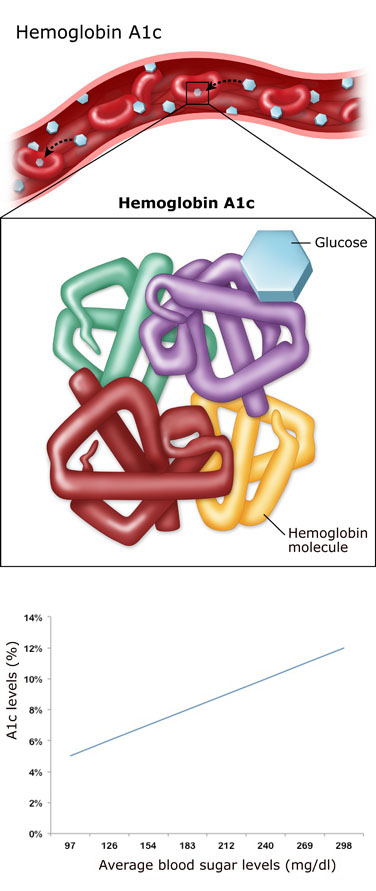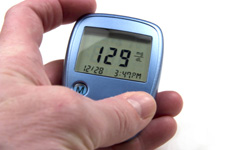Glysolated Hemoglobin (or A1c) is a measure of your average blood glucose control over the previous three months.
Glucose attaches to hemoglobin the oxygen carrying molecule in red blood cells. The glucose-hemoglobin unit is called glycosolated hemoglobin. As red blood cells live an average of three months, the glycosolated hemoglobin reflects the sugar exposure to the cells over that time.

The higher the amount of glucose in the blood, the higher the percentage of hemoglobin molecules that will have glucose attached. Think of the A1c as a long-term blood glucose measure that changes very gradually as red blood cells die and are replaced by new cells.
The A1c is not used to diagnose diabetes and it doesn’t replace self blood-glucose monitoring. Because the A1c is an average of all your blood sugars, it does not tell you your blood sugar patterns. For example, one person with frequent highs and lows can have the same A1c as another person with very stable blood sugars that don’t vary too much.
So what’s the point?
A1c is yet another indicator of how well you’re doing.
- An A1c measurement between 4-6% is considered the range that someone without diabetes will have.
- The American Diabetes Association goal is an A1c less than 7%. Research has shown that an A1c less than 7% lowers risk for complications.
- The American College of Endocrinology goal is an A1c less than 6.5%.
- For some people with diabetes an A1c goal of less than 6% is appropriate.
- Talk with your doctor about your A1c goal.
Use this chart to view A1c values and comparable blood glucose values:
| A1c | Estimated Average Glucose mg/dL |
|---|---|
| 5% | 97 |
| 6% | 126 |
| 7% | 154 |
| 8% | 183 |
| 9% | 212 |
| 10% | 240 |
| 11% | 269 |
| 12% | 298 |
A note of caution: the A1c measurement is not always accurate. For example, if someone has certain type of hemoglobin mutations (variation in the hemoglobin structure), is severely anemic (low red blood cell count), or is being treated blood transfusions or medications to increase the production of new red blood cells, the A1c test may not be accurate.
If your finger-stick blood tests give an average blood sugar that is much higher or lower than your A1c test, ask your doctor if the A1c is the right test for you. An alternative test to the A1c is a fructosamine test. Unfortunately, the fructosamine test and the A1c are not interchangeable because they are measuring different things. The fructosamine test reflects the average blood sugars only over a 2-3 week period.
Self-assessment Quiz
Self assessment quizzes are available for topics covered in this website. To find out how much you have learned about Monitoring Your Diabetes, take our self assessment quiz when you have completed this section. The quiz is multiple choice. Please choose the single best answer to each question. At the end of the quiz, your score will display. If your score is over 70% correct, you are doing very well. If your score is less than 70%, you can return to this section and review the information.
